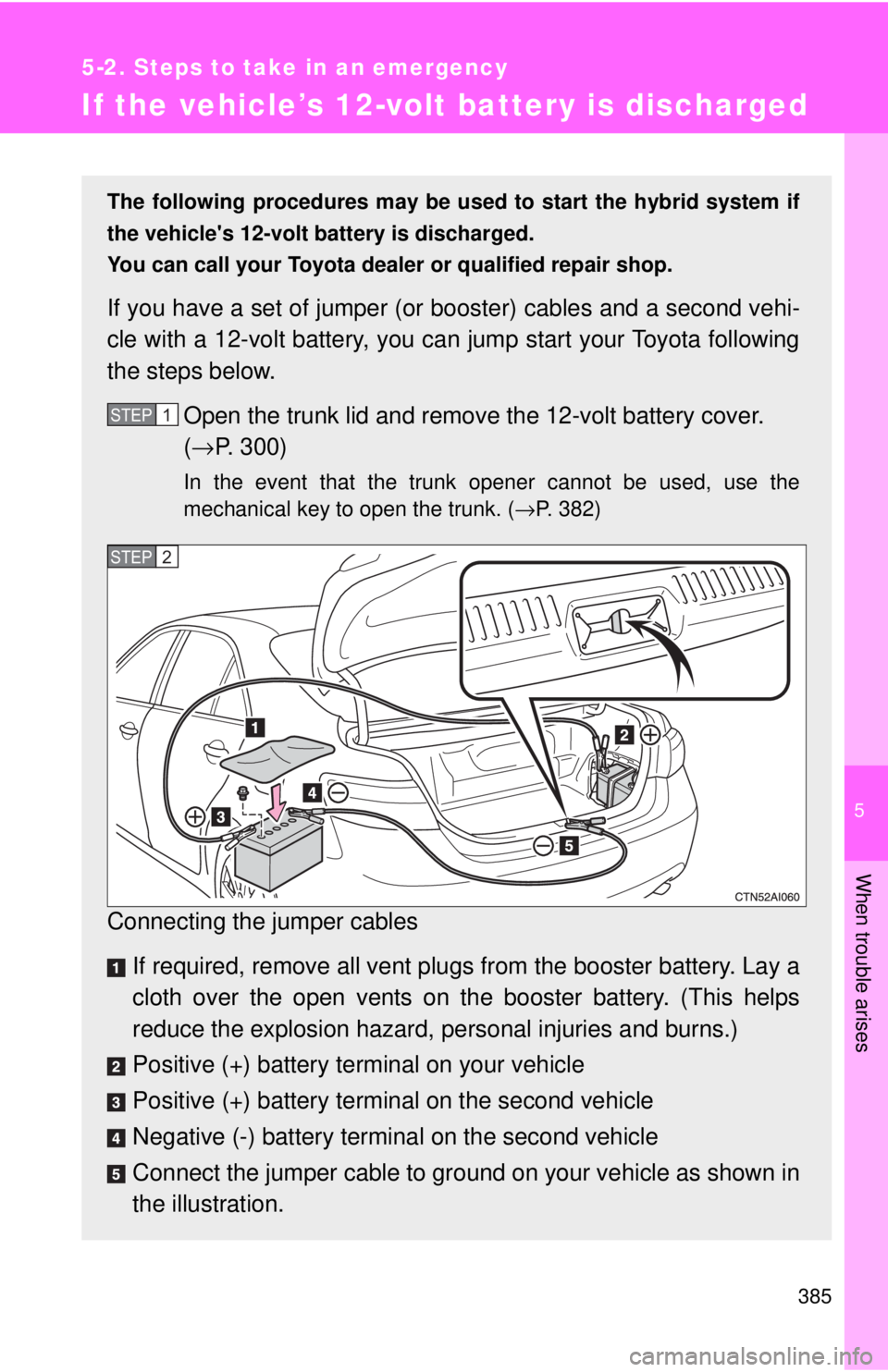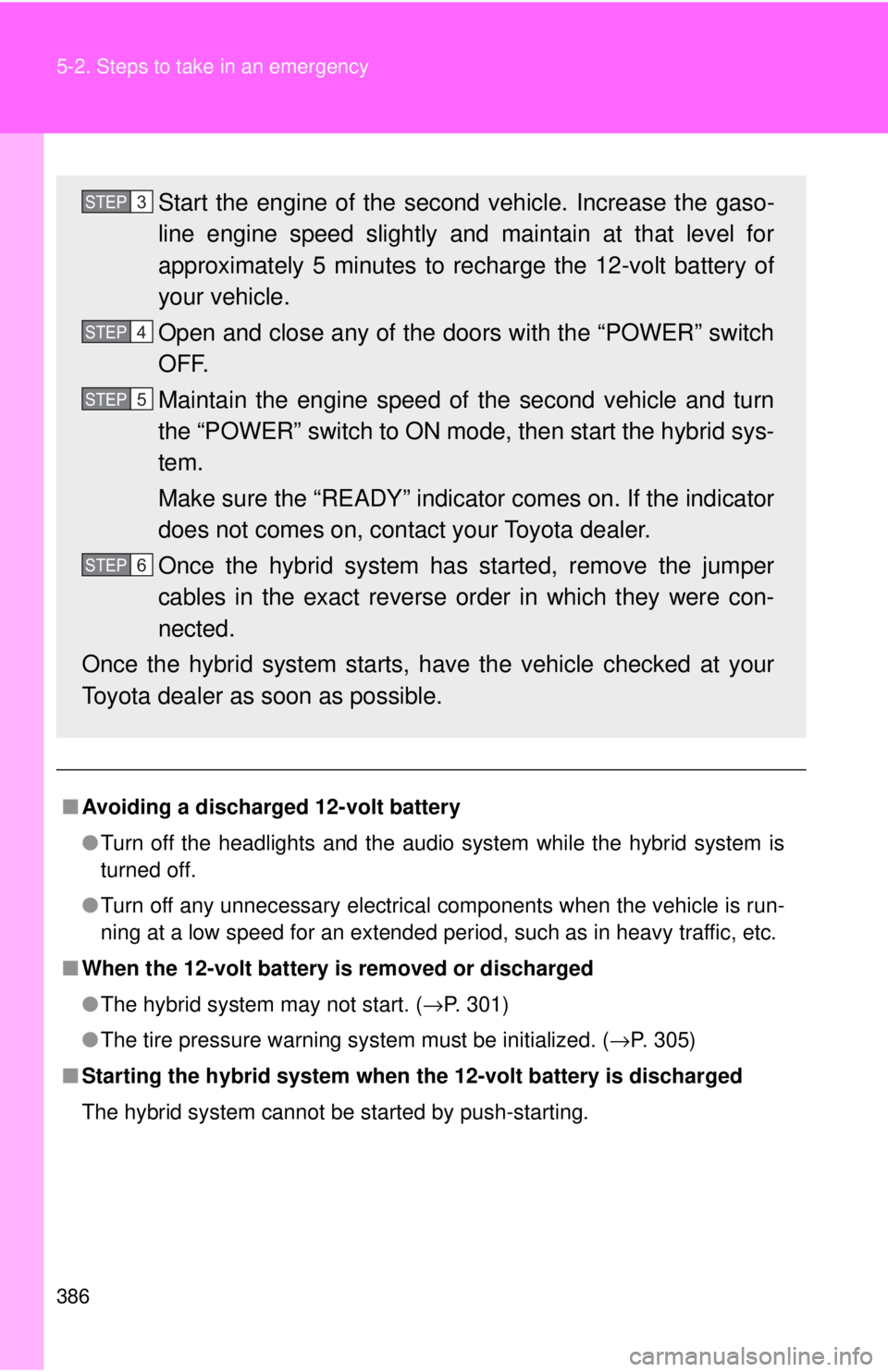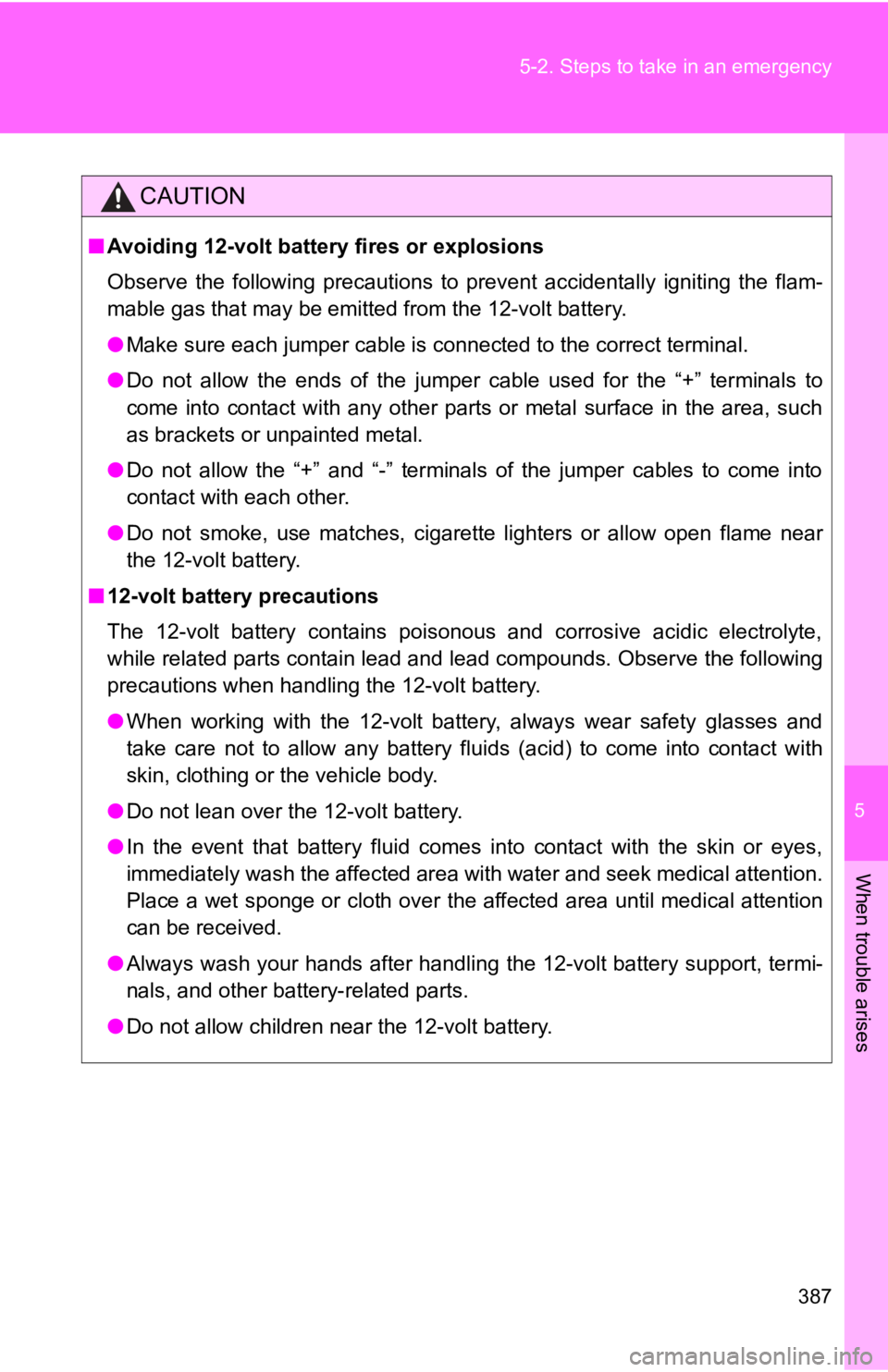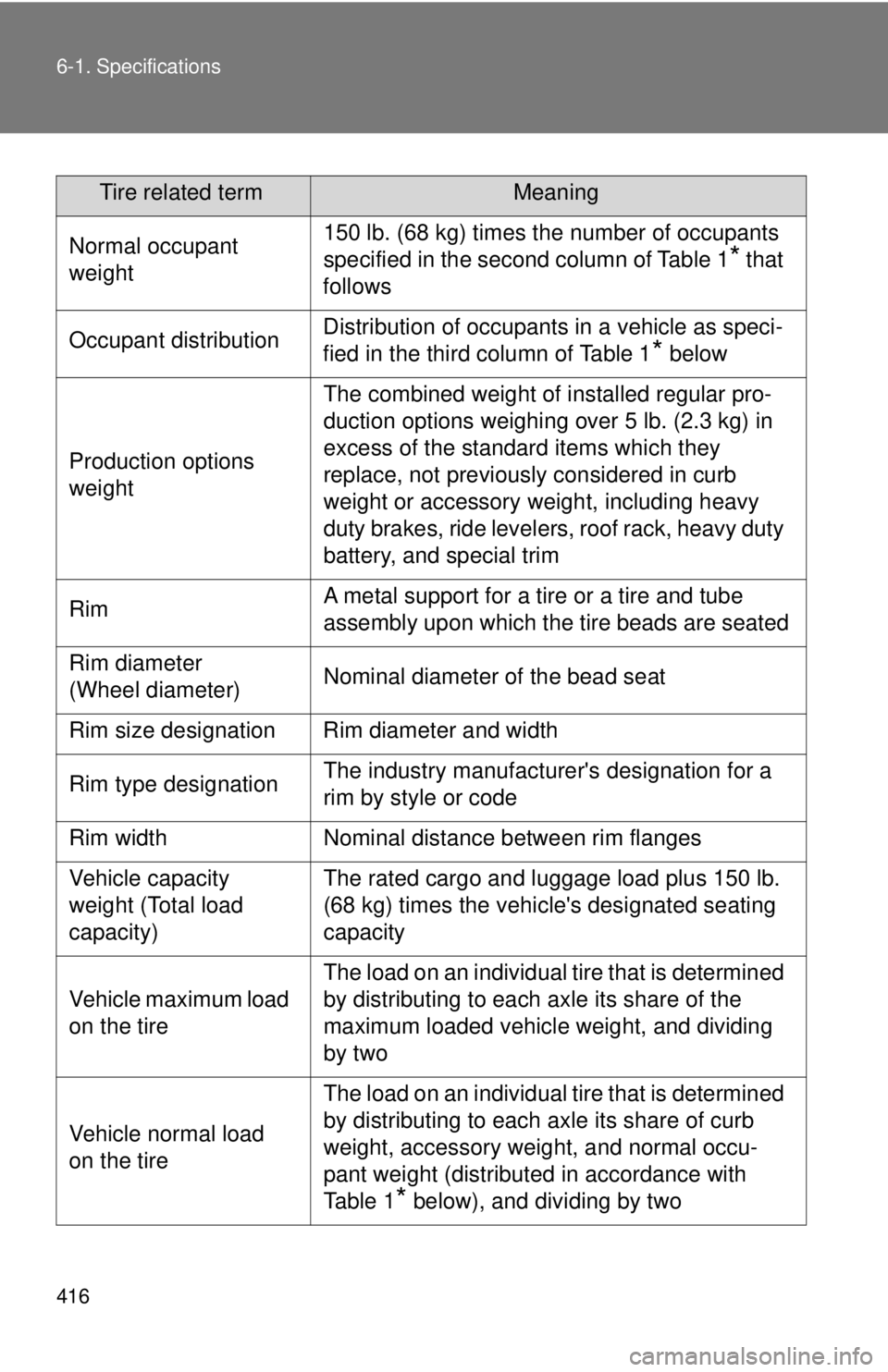2009 TOYOTA CAMRY HV battery
[x] Cancel search: batteryPage 385 of 444

5
When trouble arises
385
5-2. Steps to take in an emergency
If the vehicle’s 12-volt battery is discharged
The following procedures may be used to start the hybrid system if
the vehicle's 12-volt battery is discharged.
You can call your Toyota dealer or qualified repair shop.
If you have a set of jumper (or boo ster) cables and a second vehi-
cle with a 12-volt battery, you can jump start your Toyota following
the steps below.
Open the trunk lid and remove the 12-volt battery cover.
(→ P. 300)
In the event that the trunk opener cannot be used, use the
mechanical key to open the trunk. ( →P. 382)
Connecting the jumper cables
If required, remove all vent plugs from the booster battery. Lay a
cloth over the open vents on the booster battery. (This helps
reduce the explosion hazard, personal injuries and burns.)
Positive (+) battery terminal on your vehicle
Positive (+) battery terminal on the second vehicle
Negative (-) battery terminal on the second vehicle
Connect the jumper cable to ground on your vehicle as shown in
the illustration.
STEP1
STEP2
Page 386 of 444

386 5-2. Steps to take in an emergency
■Avoiding a discharged 12-volt battery
●Turn off the headlights and the audio system while the hybrid system is
turned off.
● Turn off any unnecessary electrical components when the vehicle is run-
ning at a low speed for an extended period, such as in heavy traffic, etc.
■ When the 12-volt battery is removed or discharged
●The hybrid system may not start. ( →P. 301)
● The tire pressure warning system must be initialized. ( →P. 305)
■ Starting the hybrid system when the 12-volt battery is discharged
The hybrid system cannot be started by push-starting.
Start the engine of the second vehicle. Increase the gaso-
line engine speed slightly and maintain at that level for
approximately 5 minutes to recharge the 12-volt battery of
your vehicle.
Open and close any of the doors with the “POWER” switch
OFF.
Maintain the engine speed of the second vehicle and turn
the “POWER” switch to ON mode, then start the hybrid sys-
tem.
Make sure the “READY” indicator comes on. If the indicator
does not comes on, contact your Toyota dealer.
Once the hybrid system has started, remove the jumper
cables in the exact reverse order in which they were con-
nected.
Once the hybrid system starts, ha ve the vehicle checked at your
Toyota dealer as soon as possible.STEP3
STEP4
STEP5
STEP6
Page 387 of 444

5
When trouble arises
387
5-2. Steps to take in an emergency
CAUTION
■
Avoiding 12-volt battery fires or explosions
Observe the following precautions to prevent accidentally igniting the flam-
mable gas that may be emitted from the 12-volt battery.
●Make sure each jumper cable is connected to the correct terminal.
● Do not allow the ends of the jumper cable used for the “+” terminals to
come into contact with any other parts or metal surface in the area, such
as brackets or unpainted metal.
● Do not allow the “+” and “-” terminals of the jumper cables to come into
contact with each other.
● Do not smoke, use matches, cigarette lighters or allow open flame near
the 12-volt battery.
■ 12-volt battery precautions
The 12-volt battery contains poisonous and corrosive acidic electrolyte,
while related parts contain lead and lead compounds. Observe the following
precautions when handling the 12-volt battery.
●When working with the 12-volt battery, always wear safety glasses and
take care not to allow any battery fluids (acid) to come into contact with
skin, clothing or the vehicle body.
● Do not lean over the 12-volt battery.
● In the event that battery fluid comes into contact with the skin or eyes,
immediately wash the affected area with water and seek medical attention.
Place a wet sponge or cloth over the affected area until medical attention
can be received.
● Always wash your hands after handling the 12-volt battery support, termi-
nals, and other battery-related parts.
● Do not allow children near the 12-volt battery.
Page 399 of 444

399
6-1. Specifications
6
Vehicle specifications
Hybrid battery (traction battery)
Type
Nickel-Metal hydride battery
Voltage7.2 V/module
Capacity6.5 Ah (3HR)
Quantity 34 modules
Overall voltage 244.8 V
Page 402 of 444

402 6-1. Specifications
Electrical system
Transaxle
*: The fluid capacity is the quantity of reference. If replacement is nec- essary, contact your Toyota dealer.
12-volt battery
Open voltage at
68° F (20 °C): 12.6
⎯ 12.8 V Fully charged
12.2 ⎯ 12.4 V Half charged
11.8 ⎯ 12.0 V Discharged
(Voltage checked 20 minutes after the
hybrid system and all the lights are turned
off)
Charging rates 5 A max.
Fluid capacity
(drain and refill)4.3 qt. (4.1 L, 3.7 Imp.qt.)*
Fluid type
Toyota Genuine ATF WS
NOTICE
■Transmission fluid type
Using transmission fluid other than “Toyota Genuine ATF WS” may cause
deterioration in shift quality, locking up of your transmission accompanied by
vibration, and ultimately damage the transmission of your vehicle.
Page 416 of 444

416 6-1. Specifications
Tire related termMeaning
Normal occupant
weight 150 lb. (68 kg) times the number of occupants
specified in the second column of Table 1
* that
follows
Occupant distribution Distribution of occupants in a vehicle as speci-
fied in the third column of Table 1
* below
Production options
weight The combined weight of
installed regular pro-
duction options weighing over 5 lb. (2.3 kg) in
excess of the standard items which they
replace, not previously considered in curb
weight or accessory weight, including heavy
duty brakes, ride levelers, roof rack, heavy duty
battery, and special trim
Rim A metal support for a tire or a tire and tube
assembly upon which the tire beads are seated
Rim diameter
(Wheel diameter) Nominal diameter of the bead seat
Rim size designation Rim diameter and width
Rim type designation The industry manufacturer's designation for a
rim by style or code
Rim width Nominal distance between rim flanges
Vehicle capacity
weight (Total load
capacity) The rated cargo and luggage load plus 150 lb.
(68 kg) times the vehicl
e's designated seating
capacity
Vehicle maximum load
on the tire The load on an individual tire that is determined
by distributing to each axle its share of the
maximum loaded vehicle weight, and dividing
by two
Vehicle normal load
on the tire The load on an individual tire that is determined
by distributing to each axle its share of curb
weight, accessory weight, and normal occu-
pant weight (distributed
in accordance with
Ta b l e 1
* below), and dividing by two
Page 433 of 444

433
Alphabetical index
Alphabetical index
A/C ............................................ 174
ABS........................................... 158
Air conditioning filter .............. 319
Air conditioning systemAir conditioning filter ............. 319
Automatic air conditioning system................................ 174
Airbags Airbag operating conditions .... 91
Airbag precautions for your child...................................... 95
Airbag warning light .............. 349
Curtain shield airbag operating conditions ............. 92
Curtain shield airbag precautions .......................... 95
Front passenger occupant classification system .......... 100
General airbag precautions .... 95
Locations of airbags ............... 88
Modification and disposal of airbags ................................. 99
Proper driving posture ...... 86, 95
Side airbag operating conditions ............................. 92
Side airbag precautions.......... 95
SRS airbags ........................... 88
Antenna .................................... 189
Anti-lock brake system ........... 158
Armrest .................................... 261
Ashtray ..................................... 256
Audio input .............................. 210
Audio system
Antenna ................................ 189
Audio input ........................... 210
AUX adapter ......................... 210
CD player/changer ............... 192
MP3/WMA disc ..................... 199
Optimal use .......................... 207 Portable music player............210
Radio .....................................186
Steering wheel audio
switch ..................................211
Type ......................................183
Automatic air conditioning system ....................................174
Automatic light control system ....................................149
AUX adapter .............................210
Auxiliary boxes ........................251
Back-up lights
Wattage .................................405
Battery
Checking ...............................300
Hybrid battery (traction battery)....................25
If the vehicle has discharged 12-volt battery .....................385
Preparing and checking before
winter ..................................166
Bluetooth
®................................213
Brake
Fluid ......................................298
Parking brake ........................138
Brake assist ..............................158
Break-in tips .............................121
Care
Exterior ..................................274
Interior ...................................276
Seat belts ..............................277
Cargo capacity .........................162
Cargo net ..................................263
CD changer ...............................192
CD player ..................................192
Chains .......................................166
A
B
C
Page 434 of 444

434 Alphabetical index
Child restraint systemBooster seats, definition ........ 105
Booster seats, installation ..... 109
Convertible seats, definition ............................. 105
Convertible seats, installation ........................... 109
Front passenger occupant
classification system ........... 100
Infant seats, definition ........... 105
Infant seats, installation......... 109
Installing CRS with lower anchorages ......................... 113
Installing CRS with
seat belts ............................ 110
Installing CRS with top straps .................................. 115
Child safety Airbag precautions ..................95
Child restraint system............ 105
Child-protectors .......................51
How your child should wear the seat belt ..........................64
Installing child restraints ........ 109
Moon roof precautions ............77
Power window lock switch.......73
Power window precautions .....74
Removed key battery precautions ......................... 323
Seat belt comfort guide ........... 61
Seat belt extender precautions ...........................67
Seat belt precautions ..............65
Seat heater precautions ........ 259
Trunk precautions ...................55
12-volt battery precautions ................. 302, 387
Child-protectors .........................51 Cleaning
Exterior.................................. 274
Interior ................................... 276
Seat belts .............................. 277
Clock ......................................... 255
Compass................................... 269
Condenser ................................ 298
Console box ............................. 248
Cooling system
Engine overheating ............... 389
Cruise control .......................... 155
Cup holder ................................ 250
Curtain shield airbags ............... 88
Customizable features ............ 421
Daytime running light
system .................................... 151
Defogger Rear window ......................... 182
Side mirror ............................ 182
Dimension ................................ 396
Dinghy towing .......................... 171
Display Trip information ..................... 146
Warning message ................. 357
Do-it-yourself maintenance .... 285
Door courtesy light Door courtesy light ................ 244
Wattage................................. 405
Doors Door glasses ........................... 73
Door lock ..................... 36, 47, 50
Side mirrors............................. 71
Driver's seat belt reminder
light ......................................... 351
Driving Break-in tips .......................... 121
Correct posture ....................... 86
Procedures............................ 120
Winter driving tips ................. 166
D